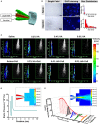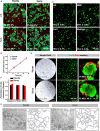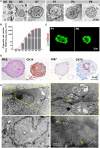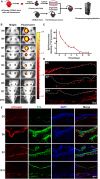Auto Micro Atomization Delivery of Human Epidermal Organoids Improves Therapeutic Effects for Skin Wound Healing
- PMID: 32154237
- PMCID: PMC7046802
- DOI: 10.3389/fbioe.2020.00110
Auto Micro Atomization Delivery of Human Epidermal Organoids Improves Therapeutic Effects for Skin Wound Healing
Abstract
Severe skin wounds are often associated with large areas of damaged tissue, resulting in substantial loss of fluids containing electrolytes and proteins. The net result is a vulnerability clinically to skin infections. Therapies aiming to close these large openings are effective in reducing the complications of severe skin wounds. Recently, cell transplantation therapy showed the potential for rapid re-epithelialization of severe skin wounds. Here, we show the improved effects of cell transplantation therapy using a robust protocol of efficient expansion and delivery of epidermal cells for treatment of severe skin wounds. Human skin tissues were used to generate human epidermal organoids maintained under newly established culture conditions. The human epidermal organoids showed an improved capacity of passaging for at least 10 rounds, enabling organoids to expand to cell numbers required for clinical applications. A newly designed auto micro-atomization device (AMAD) was developed for delivery of human epidermal organoids onto the sites of severe skin wounds enhancing uniform and concentrated delivery of organoids, facilitating their engraftment and differentiation for skin reconstitution. With the optimal design and using pneumatic AMAD, both survival and functions of organoids were effectively protected during the spraying process. Cells in the sprayed human epidermal organoids participated in the regeneration of the epidermis at wound sites in a mouse model and accelerated wound healing significantly. The novel AMAD and out new protocol with enhanced effects with respect to both organoid expansion and efficient transplantation will be used for clincal treatments of complex, uneven, or large-area severe skin wounds.
Keywords: auto micro atomization device (AMAD); cell delivery; cell therapy; organoids; wound healing.
Copyright © 2020 Chang, Liu, Guo, Fang, Wang, Wang, Liu, Reid and Wang.
Figures






Similar articles
-
Development of pluripotent stem cell-derived epidermal organoids that generate effective extracellular vesicles in skin regeneration.Biomaterials. 2024 Jun;307:122522. doi: 10.1016/j.biomaterials.2024.122522. Epub 2024 Feb 23. Biomaterials. 2024. PMID: 38428092
-
[Effects of human adipose-derived mesenchymal stem cells and platelet-rich plasma on healing of wounds with full-thickness skin defects in mice].Zhonghua Shao Shang Za Zhi. 2018 Dec 20;34(12):887-894. doi: 10.3760/cma.j.issn.1009-2587.2018.12.013. Zhonghua Shao Shang Za Zhi. 2018. PMID: 30585053 Chinese.
-
[Effects and mechanism of rat epidermal stem cells treated with exogenous vascular endothelial growth factor on healing of deep partial-thickness burn wounds in rats].Zhonghua Shao Shang Za Zhi. 2020 Mar 20;36(3):195-203. doi: 10.3760/cma.j.cn501120-20191125-00441. Zhonghua Shao Shang Za Zhi. 2020. PMID: 32241045 Chinese.
-
Scar-free healing: from embryonic mechanisms to adult therapeutic intervention.Philos Trans R Soc Lond B Biol Sci. 2004 May 29;359(1445):839-50. doi: 10.1098/rstb.2004.1475. Philos Trans R Soc Lond B Biol Sci. 2004. PMID: 15293811 Free PMC article. Review.
-
Epidermal Stem Cells in Skin Wound Healing.Adv Wound Care (New Rochelle). 2017 Sep 1;6(9):297-307. doi: 10.1089/wound.2017.0728. Adv Wound Care (New Rochelle). 2017. PMID: 28894637 Free PMC article. Review.
Cited by
-
Advances in Skin Tissue Engineering and Regenerative Medicine.J Burn Care Res. 2023 Jan 2;44(Suppl_1):S33-S41. doi: 10.1093/jbcr/irac126. J Burn Care Res. 2023. PMID: 36567474 Free PMC article.
-
Layer-by-layer assembly: advancing skin repair, one layer at a time.RSC Adv. 2025 Apr 29;15(18):13908-13923. doi: 10.1039/d4ra08115c. eCollection 2025 Apr 28. RSC Adv. 2025. PMID: 40303355 Free PMC article. Review.
-
Organoids/organs-on-chips towards biomimetic human artificial skin.Burns Trauma. 2025 May 3;13:tkaf029. doi: 10.1093/burnst/tkaf029. eCollection 2025. Burns Trauma. 2025. PMID: 40740685 Free PMC article. Review.
-
Advances in engineered organoid models of skin for biomedical research.Burns Trauma. 2025 Feb 23;13:tkaf016. doi: 10.1093/burnst/tkaf016. eCollection 2025. Burns Trauma. 2025. PMID: 40799298 Free PMC article. Review.
References
-
- Bahoric A., Harrop A. R., Clarke H. M., Zuker R. M. (1997). Aerosol vehicle for delivery of epidermal cells – an in vitro study. Can. J. Plast. Surg. 5, 153–156. 10.1177/229255039700500301 - DOI
LinkOut - more resources
Full Text Sources

